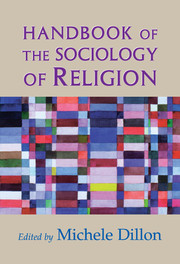Book contents
- Frontmatter
- Contents
- List of Contributors
- Acknowledgment
- Part One Religion as a Field of Sociological Knowledge
- Part Two Religion and Social Change
- Part Three Religion and the Life Course
- Part Four Religion and Social Identity
- 16 Religious Identities and Religious Institutions
- 17 Religion and the New Immigrants
- 18 A Journey of the “Straight Way” or the “Roundabout Path”
- 19 Beyond the Synagogue Walls
- 20 Dis/location
- Part Five Religion, Political Behavior, and Public Culture
- Part Six Religion and Socioeconomic Inequality
- References
- Index
18 - A Journey of the “Straight Way” or the “Roundabout Path”
Jewish Identity in the United States and Israel
Published online by Cambridge University Press: 05 June 2012
- Frontmatter
- Contents
- List of Contributors
- Acknowledgment
- Part One Religion as a Field of Sociological Knowledge
- Part Two Religion and Social Change
- Part Three Religion and the Life Course
- Part Four Religion and Social Identity
- 16 Religious Identities and Religious Institutions
- 17 Religion and the New Immigrants
- 18 A Journey of the “Straight Way” or the “Roundabout Path”
- 19 Beyond the Synagogue Walls
- 20 Dis/location
- Part Five Religion, Political Behavior, and Public Culture
- Part Six Religion and Socioeconomic Inequality
- References
- Index
Summary
Jewish identity has not remained the same throughout the four millennia, which span the development of Jewish civilization. Nor is Jewish identity identical in all of the societies of the contemporary world in which Jews find themselves. It therefore may be useful to conceive of Jewish identity as a journey, which for some has been a “straight way” (figuratively the traditional trajectory embodied in Jewish religious law or “halakhah”), and for others a “roundabout path,” embodying a more circuitous byway to being Jewish (whose entry points do not necessarily follow the traditional road traveled but, rather, individual choices). This distinction highlights the difference between the historic approach in Jewish civilization giving greater weight to communal responsibility vis-à-vis individual rights as compared to the reverse emphasis in modern American and European civilizations.
In this chapter, we will focus on understanding Jewish identity as it dawns in the twenty-first century by focusing on the two largest concentrations of Jewry in the world: The United States with approximately six million Jews, who represent only about 2 percent of the total population, and Israel with approximately five million Jews, where they represent about 80 percent of the population. Most of the remaining more than two million Jews worldwide are scattered in various countries in Europe and the Americas. We begin with a review of the evolution of Jewish identity within Jewish civilization, go on to examine the conceptualization and measurement of that identity in sociology and the social sciences, review the sources (with special reference to gender) and consequences as well as the role of denominations in shaping identity, and finally offer some concluding thoughts and implications for further research.
- Type
- Chapter
- Information
- Handbook of the Sociology of Religion , pp. 240 - 260Publisher: Cambridge University PressPrint publication year: 2003
- 18
- Cited by



